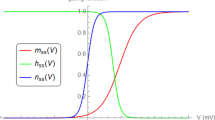Abstract
A computer model for the simulation of compound nerve action potentials, based on superposition of volume conducted single nerve fibre potentials, is presented. The model assumes that the intracellular fibre potential, the fibre diameter distribution and the electrical conductivities of different tissues are known. Volume conductor fields are calculated in the spatial frequency domain. The influence of important parametrrs in the model is evaluated numerically. It is shown that it is necessary to give up the usual assumption of homogeneity and isotropy in the extracellular medium. In the present model parameters are introduced which allow an overall description of the complex morphological and physiological structure of the nerve trunk. Simulation results indicate that the model is a rather promising tool in studying the main properties of compound action potentials which up till now have not been sufficiently well understood.
Similar content being viewed by others
References
Abramowitz, M., Stegun, I.A.: Handbook of mathematical functions. New York: Dover 1970
Barker, A.T.: Determination of the distribution of conduction velocities in human nerve trunks. Ph.D. Thesis, Univ. of Sheffield 1976
BeMent, S.L., Olson, W.H.: Quantitative studies of sequential peripheral nerve fibre diameter histograms and biophysical implications. Exp. Neurol. 57, 828–848 (1977)
Boyd, D.C., Lawrence, P.D., Bratty, P.J.A.: On modeling the single motor unit action potential. IEEE Trans. Biomed. Eng. 25, 236–242 (1978)
Broman, H., Lindström, L.: A model describing the power spectrum of myoelectric signals, Part II: Motor unit signal. Göteborg: Chalmers Univ. of Technology 1974
Buchthal, F., Rosenfalck, A.: Evoked action potentials and conduction velocity in human sensory nerves. Brain Res. 3, 1–122 (1966)
Buchthal, F., Rosenfalck, A., Behse, F.: Sensory potentials of normal and diseased nerve. In: Peripheral neuropathy. Dyck, P.J., Thomas, P.K., Lambert, E.H., eds., p. 442–464. Philadelphia: Saunders 1975
Burger, H.C.: Heart and vector. Eindhoven: Philips Technical Library 1968
Burke, D., Mackenzie, R.A., Skuse, N.F., Lethlean, A.K.: Cutaneous afferent activity in median and radial nerve fascicles: A microelectrode study. J. Neurol. Neurosurg. Psychiatry 38, 855–864 (1975)
Clark, J.W., Plonsey, R.: A mathematical evaluation of the core conductor model. Biophys. J. 6, 95–112 (1966)
Clark, J.W., Plonsey, R.: The extracellular potential field of the single active nerve fiber in a volume conductor. Biophys. J. 8, 842–864 (1968)
Clark, J.W., Plonsey, R.: A mathematical study of nerve fiber interaction. Biophys. J. 10, 937–957 (1970)
Dawson, G.D.: The relative excitibility and conduction velocity of sensory and motor nerve fibres in man. J. Physiol. 131, 436–451 (1956)
De Weerd, J.P.C., Notermans, S.L.H., Vingerhoets, H.M.: Measurement of the refractory period in human sensory nerve fibres (Abstract). Electroencephalogr. Clin. Neurophysiol. (in press)
Esplin, D.W.: Independence of conduction velocity among myelinated fibres in cat nerve. J. Neurophysiol. 25, 805–811 (1962)
Gasser, H.S., Erlanger, J.: The role played by the sizes of the constituent fibres of a nerve trunk in determining the shape of its action potential wave. Am. J. Physiol. 80, 522–547 (1927)
Geddes, L.A., Baker, L.E.: The specific resistance of biological material: A compendium of data for the biomedical engineer and physiologist. Med. Biol. Eng. 5, 271–293 (1967)
Gold, B., Rader, C.M.: Digital processing of signals. New York: McGraw-Hill 1969
Goldman, L., Albus, J.S.: Computation of impulse conduction in myelinated fibres; theoretical basis of the velocity-diameter relation. Biophys. J. 8, 596–607 (1968)
Griep, P.A.M., Boon, K.L., Stegeman, D.F.: A study of the motor unit action potential by means of computer simulation. Biol. Cybernetics 30, 221–230 (1978)
Hursch, J.B.: Conduction velocity and diameter of nerve fibres. Am. J. Physiol. 127, 131–139 (1939)
Jackson, J.D.: Classical electrodynamics. New York, London, Sydney: Wiley & Sons 1962
Lorente de Nó, R.: A study of nerve physiology. Studies from the Rockefeller Institute for Medical Research, 1947
Lowitzsch, K., Hopf, H.C., Galland, J.: Changes of sensory conduction velocity and refractory periods with decreasing tissue temperature in man. J. Neurol. 216, 181–188 (1977)
Ludin, H.P., Beyeler, F.: Temperature dependence of normal sensory nerve action potentials. J. Neurol. 216, 173–180 (1977)
Moore, J.W., Joyner, R.W., Brill, M.H., Waxman, S.G., Najar-Ioa, M.: Simulations of conduction in uniform myelinated fibers. Biophys. J. 21, 147–160 (1978)
Olson, W.H.: Peripheral nerve compound action potentials and fiber diameter histograms. Ph. D. Thesis, Univ. of Michigan 1973
Paintal, A.S.: Effects of temperature on conduction in single vagal and saphenous myelinated nerve fibres of the cat. J. Physiol. 180, 20–49 (1965)
Papoulis, A.: Probability, random variables and stochastic processes. Tokyo: McGraw-Hill 1965
Patlak, C.S.: Potential and current distribution in nerve: The effect of the nerve sheath, the number of fibres and the frequency of alternating current stimulation. Bull. Math. Biophys. 17, 287–307 (1955)
Plonsey, R.: The biophysical basis for electrocardiography. Crit. Rev. Bioeng. 1, 1–49 (1971)
Plonsey, R.: The active fiber in a volume conductor. IEEE Trans. Biomed. Eng. 21, 371–381 (1974)
Plonsey, R.: Action potential sources and their volume conductor fields. Proc. IEEE 65, 601–611 (1977)
Rosenfalck, P.: Intra- and extracellular potential fields of active nerve and muscle fibres. Ph.D. Thesis. København: Akademisk Forlag 1969
Rushton, W.A.H.: A theory of the effects of fibre size in medullated fibres. J. Physiol. 115, 101–122 (1951)
Tackman, W., Lehmann, H.J.: Refractory period in human sensory nerves. Eur. Neurol. 12, 277–292 (1974)
Author information
Authors and Affiliations
Rights and permissions
About this article
Cite this article
Stegeman, D.F., de Weerd, J.P.C. & Eijkman, E.G.J. A volume conductor study of compound action potentials of nerves in situ: The forward problem. Biol. Cybernetics 33, 97–111 (1979). https://doi.org/10.1007/BF00355258
Accepted:
Issue Date:
DOI: https://doi.org/10.1007/BF00355258




